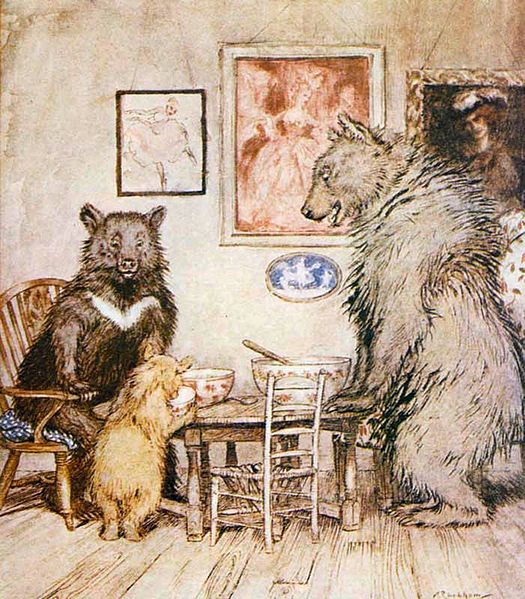
Aruthur Rackham’s illustration from GOLDILOCKS AND THE THREE BEARS from the Project Gutenberg archives.
So, you’ve subjected your manuscript to writers’ conference reviews.
- Papa Editor says your manuscript is too soft/lame/dull.
- Mama Agent says it is too hard/scary/implausible.
- And your Baby Peer Group says it is just right, except for a few hundred nagging flaws.
Now what?
- Sleep until noon.
- Eat bon-bons.
- Complain on Facebook that editors, agents, and other writers don’t know their succotash from Shinola.
Just kidding!
Post manuscript review steps
1. Detach
- Know that your reason for living is not dependent on those 600/9000/48,000 words.
- To avoid burn out and increase objectivity, let the project rest in a drawer for two weeks or more.
- Start another project. Many successful authors juggle several manuscripts at once. Epiphanies often occur while focusing on something else.
2. Look for middle ground
Note opposing revision suggestions. You can’t incorporate both, so see if the middle ground makes sense.
For instance, one manuscript reviewer advised that I intensify a storm scene to make it scarier. The next suggested that volatile weather may be too scary for children.
Because of favorable input received earlier from a test group, I plan to meet in the middle and leave the storm as is. If I didn’t feel confident and couldn’t decide which advice was best, I would save my original manuscript, rename and rewrite it the two suggested ways, and select the best.
Writing exercises are never wasted.
3. Note common threads
Listen and check your notes for common threads of advice. This indicates a weak point. A common thread regarding my aforementioned manuscript is a preference for a supporting character over the protagonist.
To improve the manuscript according to this feedback, I can:
- change my protagonist to make him/her stand out.
- advance the supporting character to the rank of protagonist, knowing this may change the genre, theme, and story.
- create an entirely new protagonist.
What critique advice have you heard more than once?
4. Note common sense
An editor noticed a scene where I had gotten sidetracked. I tend to be a bit attention deficit. SQUIRREL! To compensate for the shortcomings in my personality, I plan to change my writing process. It’s dangerous for someone like me to just write and hope it takes me to a logical place. ICE CREAM! I will need an outline to keep me on track. Common sense will save me from ending up in an entirely different story and writing ten times more material than I need.
What common sense advice speaks to you?
5. Incorporate the best advice
Save your manuscript under a new name and incorporate the common thread and common sense advice. If others, especially the professionals, agree that chapters, phrases, and words do not carry your story forward cut or change them.
You can go back to the original if you don’t like what you get. But I’m guessing you’ll be pleasantly surprised.
6. Test your manuscript
Revise, then test your manuscript with readers of the age group you are targeting. In extreme critique instances, ask your test group to select between the two different revisions and the original. If the pieces are too long, offer three different synopses for comparison.
My manuscript was originally written without a storm. The youngest member of my test group suggested one. Post-revision, the test group says the story is way cooler with a storm and it’s just the right amount of scary.
Trust your target audience. They’re the best indicator of the marketability of your story.
7. Start again (Back to Baby Peer Group, Mama Agent, and Papa Editor)
At the October 2013 Iowa SCBWI conference, a participant received a submission request from a major publishing house director. This friend started her manuscript over a decade ago.
“She’s arrived!” you say?
Not yet. She’ll follow the post-manuscript-review steps, then she’ll submit her manuscript.
I can’t wait to tell you how the story ends.

